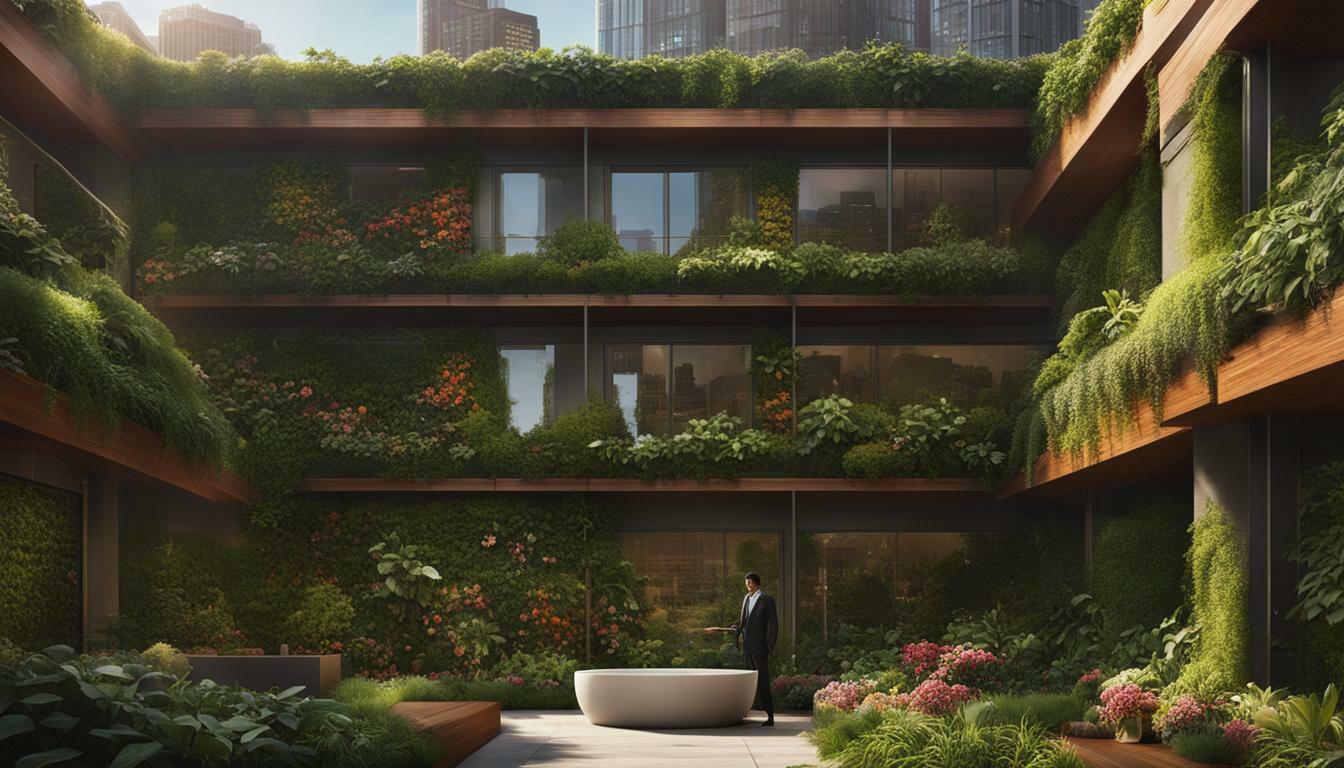Transform Your Space with an Urban Vertical Garden and create a lush green oasis in even the smallest urban areas. Limited space should not hold back your gardening dreams. With the concept of urban vertical gardening, you can turn walls, trellises, fencing, balconies, and arbors into beautiful green spaces. This innovative gardening technique allows you to grow various types of plants vertically, maximizing your garden space and adding a touch of nature to your urban environment.
Key Takeaways:
- Urban vertical gardening is a creative solution for transforming limited urban spaces into green oases.
- By growing plants vertically, you can utilize walls, trellises, and other structures to create beautiful and functional gardens.
- Vertical gardening techniques include using trellises, container plants, hydroponic systems, pallet planters, tower gardens, hanging pots, pyramid-shaped raised beds, and recycled materials.
- Trellises are a popular method for growing vining plants vertically and can be made from various materials.
- Green walls created with container plants are versatile and easy to maintain in small spaces.
- Hydroponic living walls use nutrient-rich water instead of soil and provide numerous benefits for urban gardens.
- Pallet planters offer a budget-friendly and creative option for building vertical planters, particularly for growing herbs and small plants.
- Tower gardens are specifically designed for growing edible plants vertically and are ideal for urban gardening.
- Hanging pots add visual interest and create a layered effect in urban vertical gardens.
- Pyramid-shaped raised beds are unique and space-saving options for growing a variety of plants vertically.
- Recycled materials, such as bottles or pallets, can be used to create vertical gardens, making it an eco-friendly choice.
Understanding Urban Vertical Gardening
Urban vertical gardening is a technique that involves growing plants vertically, utilizing walls, trellises, and other structures to maximize space in urban environments. This innovative approach to gardening is gaining popularity as a solution for limited space in cities, allowing individuals to transform even the smallest areas into thriving green spaces.
Vertical gardening offers several benefits for urban dwellers. It not only provides an opportunity to bring nature into the city, but it also allows for greater accessibility and ease of maintenance. With vertical gardens, you can create a stunning visual display while maximizing the use of available space.
There are various techniques and tips to consider for successful urban vertical gardening. One popular method is using trellises to support the growth of vining plants. Trellises come in different materials and can be affixed to walls or left freestanding. They not only add a decorative element to your garden but also provide structure and support for climbing plants.
Understanding Urban Vertical Gardening – Tips for Successful Implementation
| Techniques | Tips |
|---|---|
| Use trellises for vining plants | Plant vines at the base of the trellis and weave them in and out of the mesh to train them to grow upward. |
| Explore green walls of container plants | Affix pots or wall planters to fencing, exterior walls, or freestanding structures to create a vertical garden. |
| Create hydroponic living walls | Utilize nutrient-rich water and different systems to grow plants vertically without soil. |
| Build pallet planters for herbs and more | Repurpose pallets as vertical planters for growing herbs and other small plants. |
In addition to trellises, other techniques for urban vertical gardening include creating green walls of container plants, building hydroponic living walls, utilizing pallet planters, and more. These methods offer flexibility and creativity in designing your vertical garden.
By understanding the principles and techniques of urban vertical gardening, you can transform your limited urban space into a lush and vibrant oasis. Whether you have a small balcony, rooftop, or backyard, vertical gardening provides an innovative solution for bringing nature into the concrete jungle.
Vertical Garden Design Ideas
Get inspired by these innovative vertical garden design ideas that are trending in urban gardening. Whether you have a small balcony, limited outdoor space, or simply want to add a unique touch to your garden, vertical gardening offers a creative solution to transform any area into a lush and vibrant oasis.
Trellises for Vining Plants
One popular option for vertical gardening is to use trellises to support the growth of climbing plants. Trellises, typically adorned with mesh lattice, come in various materials such as wood, wire, and metal. They can be affixed to an exterior wall or left freestanding against another structure. By planting vines at the base of the trellis and weaving them through the mesh, you can train them to grow upward. Trellises not only maximize vertical space but also add visual interest to your garden.
| Advantages of Trellises for Vining Plants: |
|---|
| Produces more high-quality fruits and veggies |
| Prevents problems with pests and diseases |
| Maximizes garden space |
| Provides accessibility for people of all ages and abilities; no need for bending |
Best vining plants to grow on a trellis:
- Fruit: Blackberries, Grapes, Raspberries
- Flowers: Clematis, Honeysuckle, Morning glories
- Herbs: Nasturtium, Passion Flower, Star Jasmine
- Vegetables: Cucumbers, Melons, Pole beans
Green Walls of Container Plants
Create stunning green walls by affixing pots or wall planters to fencing, exterior walls, or freestanding structures. Container gardening allows you to cultivate a variety of plants, from flowers to herbs and vegetables, in a limited space. The versatility of container planters makes it easy to swap out plants and experiment with different arrangements. With regular watering and maintenance, you can enjoy a beautiful and thriving vertical garden.
| Advantages of Green Walls of Container Plants: |
|---|
| Easy to set up |
| Adds beauty and interest |
| No weeding is needed |
| Changing up plants and pots is easy and quick |
| Individual plant care is more accessible than in an in-ground setting |
Best plants to grow in container planters:
- Fruits: Citrus, Figs, Alpine Strawberries
- Flowers: Coleus, Geraniums, Phlox
- Herbs: Basil, Cilantro, Rosemary
- Vegetables: Broccoli, Eggplant, Tomato
Hydroponic Living Walls
Take your vertical gardening to the next level with hydroponic living walls. By using nutrient-rich water instead of soil, hydroponic systems provide a space-saving and efficient way to grow plants vertically. These systems can be as simple as DIY setups using PVC pipes or more advanced automated water recirculation systems. Hydroponic living walls offer numerous advantages, including increased property value, reduced pollution, and lower energy bills. With minimal maintenance, you can enjoy a thriving and environmentally friendly vertical garden.
| Advantages of Hydroponic Living Walls: |
|---|
| Creates more interest that increases property value |
| No soil-borne diseases |
| Reduces stress/anxiety; promotes overall well-being |
| Lowers energy bills by up to 20% |
| Reduces air, water, and noise pollution |
Best plants to grow in a hydroponic living wall:
- Fruits: Currants, Strawberries, Watermelons
- Flowers: Impatiens, Petunias, Wallflowers
- Herbs: Chives, Parsley, Sage
- Vegetables: Bell Peppers, Lettuce, Spinach
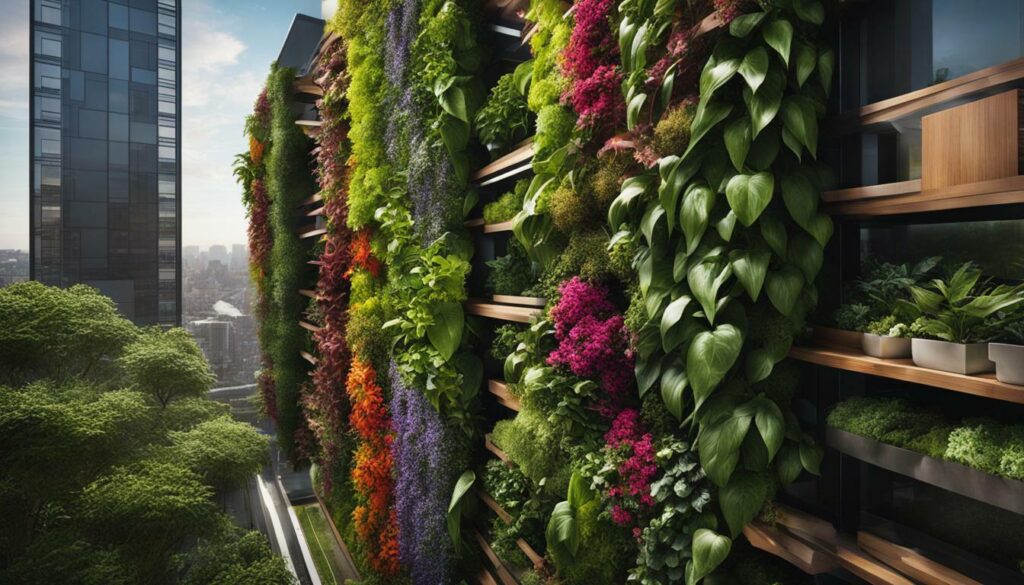
Trellises for Vining Plants
Incorporate trellises into your urban vertical garden to create a stunning display of vining plants that add height and beauty to your space. Trellises are frames made to support the growth of climbing plants, and they come in various materials such as wood, heavy plastics, wire, and metal. You can affix them to an exterior wall, leave them freestanding to lean against another structure, or try one of the trellis ideas below.
Experts at the University of Minnesota Extension recommend planting vines at the base of the trellis and weaving them in and out of the mesh while young to train them to grow upward. This method not only produces more high-quality fruits and veggies but also prevents problems with pests and diseases. By maximizing garden space and providing accessibility for people of all ages and abilities, trellises are an excellent addition to any urban garden.
When it comes to maintenance, trellises may require replacing building components such as wood, wire, and metal from time to time, as each can decay after a few years. Regular upkeep, such as repainting wood, pruning back dead vines, and maintaining the ground area clear of leaves and debris, ensures the longevity and aesthetics of your trellis. The cost of a trellis varies depending on the material used, with ready-made options ranging from $12 to $100, or you can build your own using branches from trees in your yard to save on costs.
| Best Vining Plants to Grow on a Trellis | Type |
|---|---|
| Blackberries (Rubus) | Fruit |
| Grapes (Vitis) | Fruit |
| Raspberries (Rubus idaeus) | Fruit |
| Clematis (Clematis) | Flowers |
| Honeysuckle (Lonicera periclymenum) | Flowers |
| Morning glories (Ipomoea purpurea) | Flowers |
| Nasturtium (Tropaeolum majus) | Herbs |
| Passion Flower (Passiflora incarnata) | Herbs |
| Star Jasmine (Trachelospermum jasminoides) | Herbs |
| Cucumbers (Cucumis sativum) | Vegetables |
| Melons (watermelon and cantaloupes) | Vegetables |
| Pole beans (Phaseolus vulgaris) | Vegetables |
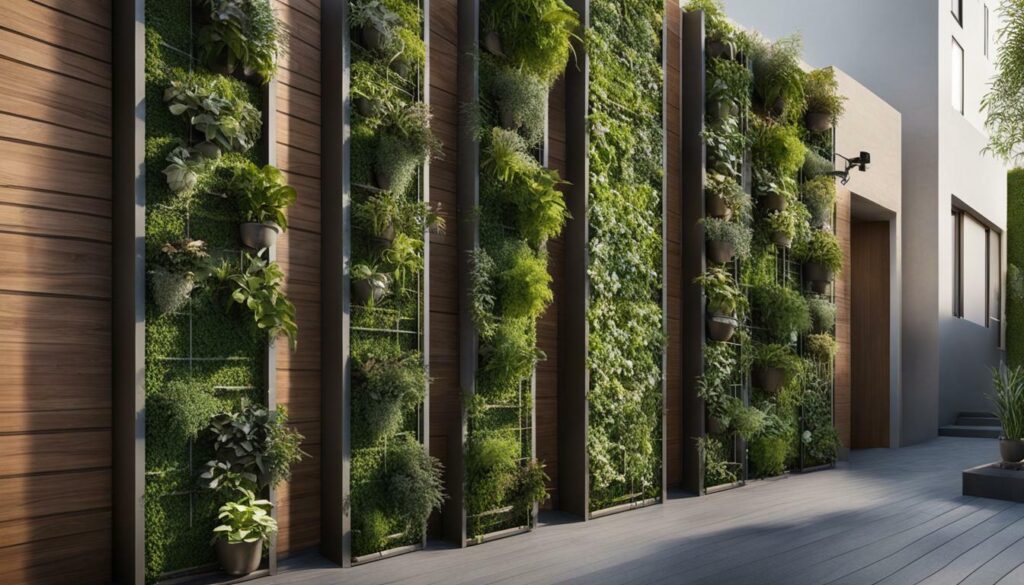
Green Walls of Container Plants
Transform a blank wall into a vibrant green canvas with a green wall of container plants, bringing nature into even the tiniest urban spaces. Green walls, also known as living walls or vertical gardens, are a popular trend in small space gardening ideas. By utilizing vertical space and container planters, you can create a stunning display of cascading foliage and colorful blooms.
Container plants are a versatile option for creating green walls. You can affix pots or wall planters to a fence, the exterior wall of your home, or a freestanding structure. This allows you to easily grow a variety of plants, from flowers and herbs to vegetables and succulents. The beauty of container gardening is that you can mix and match different plants to create a personalized and visually appealing display.
One of the advantages of container planters is their ease of set-up. You can use a variety of materials, such as terracotta pots, plastic planters, or even repurposed objects like mason jars or recycled bottles. Hang the container planters at different heights to create a layered effect and add visual interest to your green wall.
| Plants for Container Gardens | Recommended Varieties |
|---|---|
| Flowers | Petunias, Geraniums, Impatiens |
| Herbs | Basil, Rosemary, Cilantro |
| Vegetables | Tomatoes, Lettuce, Bell Peppers |
| Succulents | Jade Plant, Echeveria, String of Pearls |
Maintenance for green walls of container plants is relatively simple. Regular watering is essential to keep the plants hydrated, especially during hot summer months. You can also fertilize the plants every few weeks to ensure they receive the necessary nutrients for healthy growth. Additionally, it’s important to monitor the plants for any signs of pests or diseases and take appropriate measures to control them.
Green walls of container plants are a fantastic way to add beauty and greenery to any urban space. Whether you have a small balcony, a courtyard, or a tiny backyard, you can create a stunning vertical garden that will transform your surroundings. With a variety of plant options and creative design ideas, you can personalize your green wall to suit your style and preferences. So, get started on your urban gardening journey and enjoy the beauty of nature right at your doorstep!
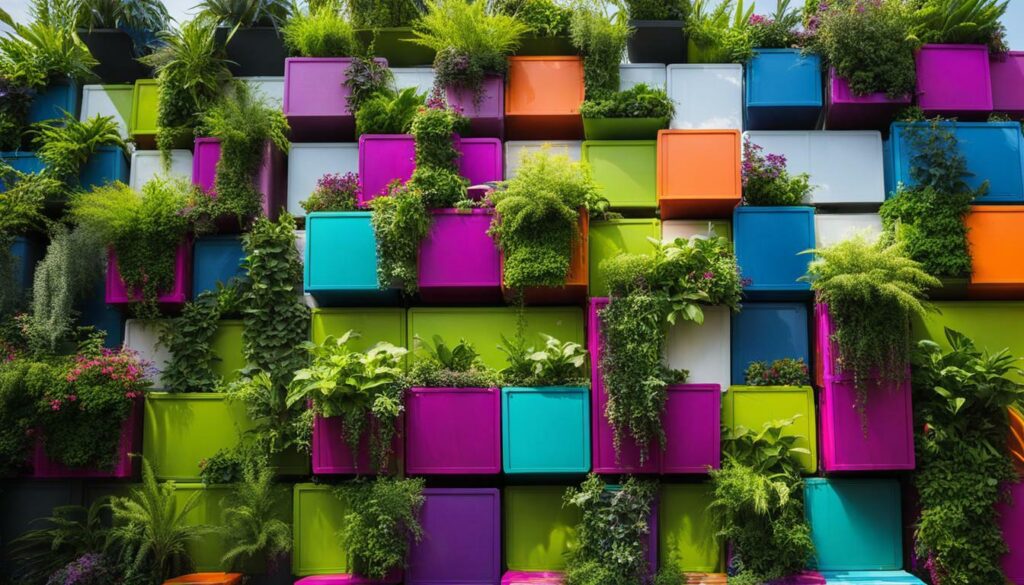
Benefits of Green Walls of Container Plants:
- Brings nature into small urban spaces
- Utilizes vertical space effectively
- Creates a vibrant and visually appealing display
- Provides a variety of plant options, including flowers, herbs, vegetables, and succulents
- Easy to set up and maintain
Hydroponic Living Walls
Embrace the future of urban gardening with hydroponic living walls, which allow you to grow a wide variety of plants without soil, maximizing space and water efficiency. Hydroponic systems use nutrient-rich water as a growing medium, delivering essential nutrients directly to the plant roots. This method eliminates the need for soil, making it ideal for urban environments with limited space.
Hydroponic living walls offer numerous advantages for urban gardeners. Firstly, they maximize vertical space by utilizing walls and other vertical structures. This is especially beneficial in urban areas where land is scarce. Additionally, hydroponic systems are highly water-efficient compared to traditional soil-based gardening methods. The water used in the system is recirculated, reducing water consumption and minimizing waste. By growing plants without soil, hydroponic living walls also eliminate the risk of soil-borne diseases and pests, resulting in healthier plants.
To create a hydroponic living wall, various systems and designs are available. One common system is the use of vertical towers or columns with individual planting pockets. These towers are equipped with a continuous flow of nutrient-rich water, ensuring that the plants receive the necessary nutrients for their growth. Another option is the use of vertical panels or modules with pre-designed plant pockets, allowing for easy installation and maintenance.
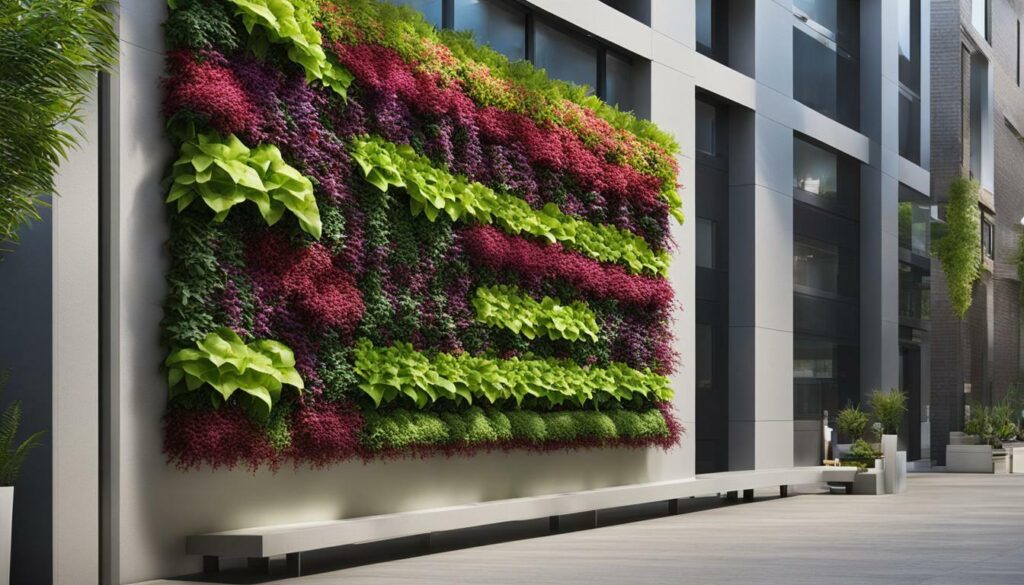
Whether you’re a seasoned gardener or a beginner, hydroponic living walls offer a versatile and efficient way to grow plants in urban environments. From herbs and leafy greens to flowers and even some fruits, the possibilities are endless. With the right combination of lighting, nutrient solutions, and plant selection, you can create a thriving vertical garden that not only adds beauty to your space but also provides you with fresh, homegrown produce.
Pallet Planters for Herbs and More
Repurpose old pallets into stylish and functional planters, perfect for growing herbs and other small plants vertically in your urban garden. Pallet planters are a budget-friendly and eco-friendly option for adding greenery to limited spaces. By utilizing vertical space, you can maximize your garden’s potential and create a beautiful and productive oasis.
One of the advantages of using pallet planters is their versatility. They can be easily customized to fit your space and design preferences. You can stack multiple pallets horizontally or vertically, creating a tiered effect for a visually appealing display. With a little creativity, you can transform a plain pallet into a stunning herb garden or a colorful display of flowers.
To create a pallet planter, start by sanding down any rough surfaces and removing any nails or staples. Paint or stain the pallet to enhance its appearance and protect it from the elements. Once the pallet is ready, line the back and bottom with landscape fabric to prevent soil from falling out. Fill the openings between the slats with potting soil and plant your desired herbs or small plants.
Here is a table showcasing some popular herbs and small plants that thrive in pallet planters:
| Herbs | Small Plants |
|---|---|
| Basil | Succulents |
| Mint | Petunias |
| Thyme | Impatiens |
| Parsley | Vinca |
| Oregano | Calibrachoa |
With proper care and maintenance, your pallet planters can provide you with a bountiful harvest of fresh herbs or a stunning display of flowers. Make sure to water the plants regularly and provide them with adequate sunlight. You can also add a layer of mulch to help retain moisture and suppress weed growth.
So, why not repurpose those old pallets and create a vertical garden that not only adds beauty to your urban space but also provides you with fresh herbs and small plants? The possibilities are endless, and the satisfaction of growing your own greenery is truly rewarding.
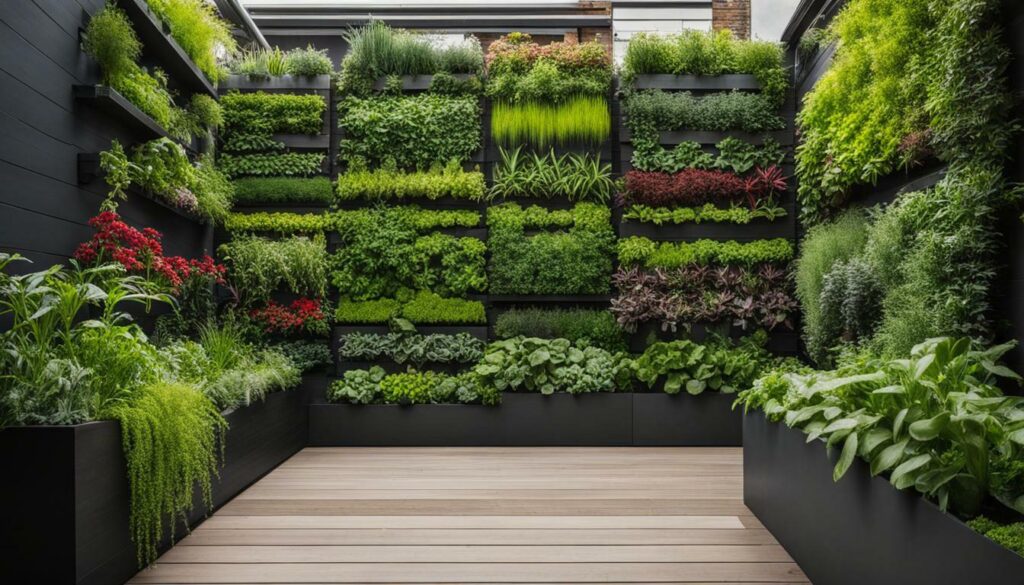
Tower Gardens for Edible Plants
Maximize your urban garden’s productivity with a tower garden, allowing you to grow a wide variety of delicious and nutritious edible plants in a compact vertical space. Tower gardens are vertical systems specifically designed for vertical gardening, offering numerous benefits for urban gardeners looking to make the most of limited space. Whether you have a small balcony, rooftop, or even just a sunny corner in your backyard, a tower garden can provide a solution for growing your own fresh produce.
One of the advantages of tower gardens is their ability to grow a large number of plants in a small footprint. These vertical systems use a series of stacked planters or trays, allowing you to grow plants both horizontally and vertically. This maximizes the use of space while also providing an efficient growing environment for your edible plants.
Tower gardens are versatile and can accommodate a wide range of edible plants, including leafy greens, herbs, vegetables, and even certain fruits. The vertical design of the garden creates a favorable microclimate, with proper air circulation and sunlight distribution, promoting healthy growth and high yields. Plus, the vertical arrangement makes it easier to access and maintain the plants, reducing the strain on your back and knees.
Tower Garden Planting Guide
When setting up your tower garden, it’s important to choose the right plants for your specific needs and growing conditions. Consider factors such as sunlight requirements, temperature tolerance, and water needs. Here are some popular edible plants that thrive in tower gardens:
| Plant | Light Requirements | Watering Needs |
|---|---|---|
| Lettuce | Partial shade to full sun | Regular watering |
| Herbs (such as basil, thyme, and mint) | Full sun | Regular watering |
| Tomatoes | Full sun | Regular watering |
| Strawberries | Partial shade to full sun | Regular watering |
| Cucumbers | Full sun | Frequent watering |
Remember to provide adequate support for taller plants, such as trellises or stakes, to ensure proper growth and prevent them from toppling over. Additionally, regular maintenance tasks such as pruning, fertilizing, and monitoring for pests and diseases are essential to keep your tower garden thriving.
With a tower garden, you can enjoy the satisfaction of growing your own fresh and healthy food, even in the most limited urban spaces. Whether you’re a seasoned gardener or just starting out, a tower garden provides a convenient and efficient solution for urban gardening. Start your vertical gardening journey today and experience the joy of harvesting your own bountiful edible plants.
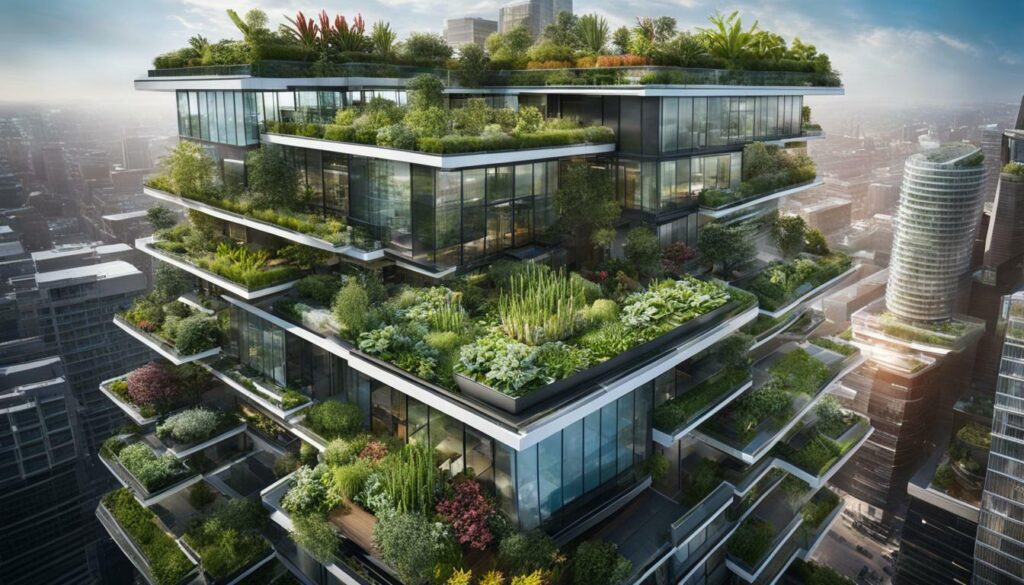
Create Visual Interest with Hanging Pots
Elevate the visual appeal of your urban vertical garden by incorporating hanging pots, adding depth and dimension to your green oasis. Hanging pots not only maximize space utilization but also create a beautiful cascading effect as plants gracefully spill over the sides. Whether you have a small balcony, limited floor space, or a bare wall, hanging pots can transform any area into a vibrant and enchanting garden.
When selecting hanging pots for your vertical garden, consider both aesthetics and functionality. Choose pots that complement your overall design scheme and fit the style of your space. You can opt for traditional terra cotta pots for a rustic look, sleek and modern pots for a contemporary feel, or colorful and patterned pots to inject a pop of personality. Additionally, ensure that the pots have proper drainage to prevent waterlogged roots and promote healthy plant growth.
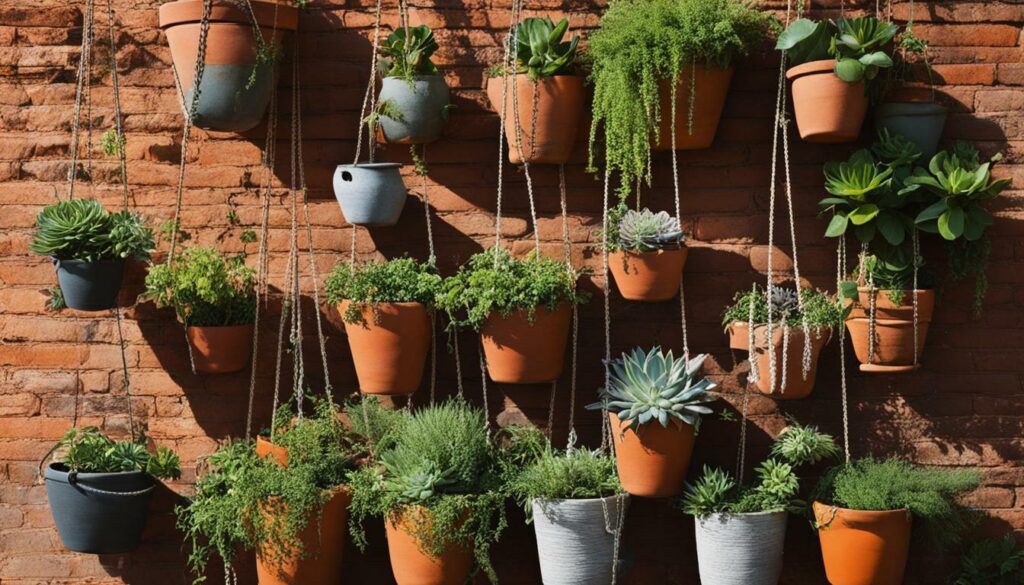
When it comes to plant selection for hanging pots, choose trailing and cascading plants that will gracefully drape over the sides, creating a cascading effect. Some popular options include trailing petunias, ivy, English ivy, and string of pearls. Mix and match different plants with varying textures, colors, and sizes to create a visually interesting display. You can also consider adding flowering plants to add a splash of color and attract pollinators to your garden.
Tips for Hanging Pot Placement:
- Hang pots at different heights to create depth and dimension in your vertical garden.
- Group pots together in clusters to create a focal point and make a statement.
- Consider the amount of sunlight each plant requires and place pots accordingly to ensure proper growth.
- Use sturdy hooks or brackets to securely hang the pots to prevent accidents or damage.
- Regularly check the soil moisture levels and water the plants accordingly, taking care not to overwater.
By incorporating hanging pots into your urban vertical garden, you can create a visually stunning and captivating space that showcases the beauty of nature in a limited area. So get creative and experiment with different plants and pot arrangements to transform your small space into a lush and inviting oasis.
| Plants for Hanging Pots | Light Requirements | Watering Needs |
|---|---|---|
| Trailing Petunias | Full sun to part shade | Regular watering |
| Ivy | Filtered sun to shade | Regular watering |
| English Ivy | Filtered sun to shade | Regular watering |
| String of Pearls | Bright, indirect light | Water when soil is dry |
Pyramid-Shaped Raised Beds
Optimize your urban gardening space with pyramid-shaped raised beds, creating a stunning focal point while maximizing planting area in limited urban spaces. These unique and eye-catching structures not only add aesthetic appeal to your garden but also provide practical benefits for growing a variety of plants vertically.
Pyramid-shaped raised beds are designed to have a tiered structure with multiple levels, allowing you to utilize vertical space efficiently. This means you can grow more plants in a smaller footprint, making it ideal for urban gardens with limited space. The tiered design also provides better access to plants, making it easier to care for and maintain your garden.
One of the advantages of pyramid-shaped raised beds is their versatility. You can grow a variety of plants in different levels, from ornamental flowers and herbs to vegetables and fruits. This allows you to create a diverse and bountiful garden that suits your preferences and culinary needs. Additionally, the vertical structure of the beds helps to improve air circulation and sunlight exposure, promoting healthy growth and reducing the risk of plant diseases.
| Advantages of Pyramid-Shaped Raised Beds |
|---|
| Maximizes planting area in small spaces |
| Creates a stunning focal point in your garden |
| Improves access to plants for easier maintenance |
| Promotes better air circulation and sunlight exposure |
When it comes to constructing pyramid-shaped raised beds, you have various materials to choose from, including wood, metal, or composite materials. Wood is a popular choice for its natural look and affordability, while metal or composite materials offer durability and longevity. It’s important to consider the materials that best suit your garden’s style, budget, and maintenance requirements.
Overall, pyramid-shaped raised beds are a fantastic solution for urban gardeners looking to maximize their planting area and create an attractive garden space. Whether you’re growing flowers, herbs, or vegetables, these raised beds offer a practical and visually appealing way to transform your limited urban space into a thriving garden.
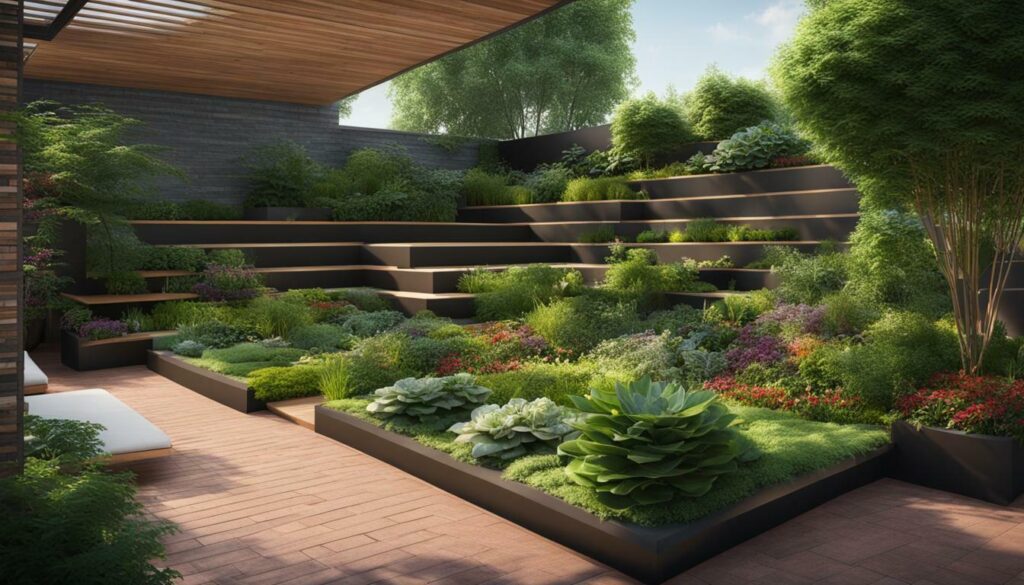
Recycled Vertical Garden
Embrace sustainable gardening practices by creating a recycled vertical garden, repurposing everyday items to transform your urban space into a flourishing green sanctuary. Vertical gardening is an innovative solution for maximizing limited space and creating a stunning visual display. By utilizing materials that would otherwise go to waste, you can create a unique and eco-friendly garden that adds beauty and charm to your surroundings.
One of the key benefits of a recycled vertical garden is the ability to repurpose various items for planting. From old pallets and shipping containers to plastic bottles and shoe organizers, there are numerous options to choose from. Not only does this reduce waste and minimize your environmental impact, but it also allows for creative and budget-friendly gardening solutions. Plus, it’s a great way to add a touch of personal flair to your space.
When creating a recycled vertical garden, it’s important to consider the specific needs of the plants you’ll be growing. Some plants thrive in containers, while others require a trellis or support structure. You can create a customized garden by selecting a mix of plants that complement each other in terms of sunlight and water requirements. This way, you can achieve a vibrant and diverse garden that brings joy and tranquility to your urban environment.
| Recycled Materials | Planting Options |
|---|---|
| Old pallets | Herbs, succulents, flowers |
| Plastic bottles | Herbs, small vegetables |
| Shipping containers | Vegetables, flowers |
| Shoe organizers | Succulents, herbs, flowers |
By repurposing everyday items and integrating them into your vertical garden, you can create a sustainable and aesthetically pleasing space. Not only will you enjoy the beauty and tranquility of nature, but you’ll also be making a positive impact on the environment. So why wait? Start your recycled vertical garden today and watch as your urban space transforms into a lush and vibrant oasis.
Conclusion
By implementing the ideas and techniques highlighted in this article, you can transform your urban space into a vibrant and thriving vertical garden, bringing the beauty of nature into your everyday life.
Whether you choose to create trellises for vining plants, green walls of container plants, hydroponic living walls, pallet planters, tower gardens, or any other creative vertical gardening solution, the possibilities are endless. These innovative approaches to gardening offer practical and aesthetically pleasing solutions for maximizing limited space in urban environments.
Not only do urban vertical gardens provide a stunning visual display, but they also offer numerous benefits. They can help improve air quality, reduce noise pollution, provide shade and insulation, increase property value, and even promote overall well-being.
So, unleash your creativity and get started on transforming your space with an urban vertical garden. With the right techniques, materials, and plant selections, you can create a green oasis that will bring joy and tranquility to your urban life.
What Are the Benefits of Urban Vertical Gardens Compared to Traditional Vertical Garden Building Techniques?
Urban vertical gardens offer numerous advantages over traditional vertical garden building techniques. Unlike conventional methods, urban vertical gardens allow for the cultivation of plants within a smaller, more confined space, making them ideal for city environments. Additionally, these innovative vertical garden building techniques promote better air quality and offer a sustainable solution for urban green spaces. Overall, urban vertical gardens provide a more efficient and effective means of incorporating greenery into urban landscapes.
FAQ
Q: What is urban vertical gardening?
A: Urban vertical gardening is a technique of arranging plants vertically in a small or limited space, such as walls, trellises, or hanging structures, to maximize space and create a green oasis in urban environments.
Q: What are the benefits of urban vertical gardening?
A: Urban vertical gardening offers several benefits, including maximizing limited space, adding greenery to urban environments, improving air quality, providing fresh produce or herbs, and creating an aesthetically pleasing and functional outdoor space.
Q: How can I implement urban vertical gardening?
A: To implement urban vertical gardening, you can use various techniques such as trellises for vining plants, green walls of container plants, hydroponic living walls, pallet planters, tower gardens, hanging pots, pyramid-shaped raised beds, and recycled vertical gardens.
Q: What types of plants are suitable for urban vertical gardening?
A: The types of plants suitable for urban vertical gardening depend on the specific technique used. Vining plants like grapes, cucumbers, and beans work well on trellises, while herbs like basil and rosemary are suitable for container gardens. Hydroponic living walls can support a variety of fruits, flowers, herbs, and vegetables.
Q: Is urban vertical gardening suitable for small spaces?
A: Yes, urban vertical gardening is ideal for small spaces as it allows you to make use of vertical surfaces, such as walls or balconies, to grow plants and maximize the available space.
Q: Are there any maintenance requirements for urban vertical gardens?
A: Maintenance requirements for urban vertical gardens vary depending on the technique used. However, common maintenance tasks include regular watering, pruning, and fertilizing. It’s also essential to monitor for pests and diseases and adjust the growing environment as needed.

